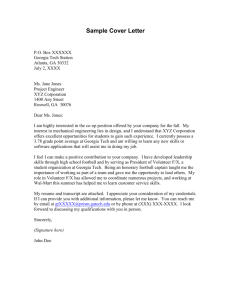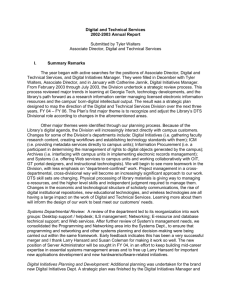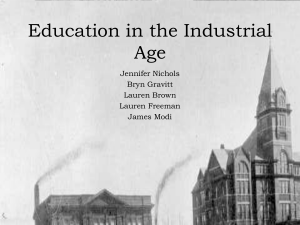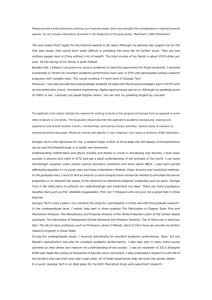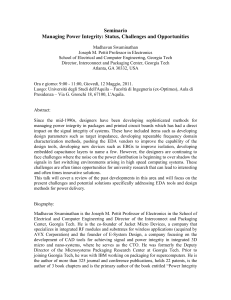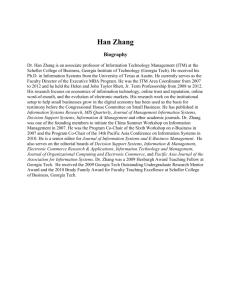0203Library
advertisement
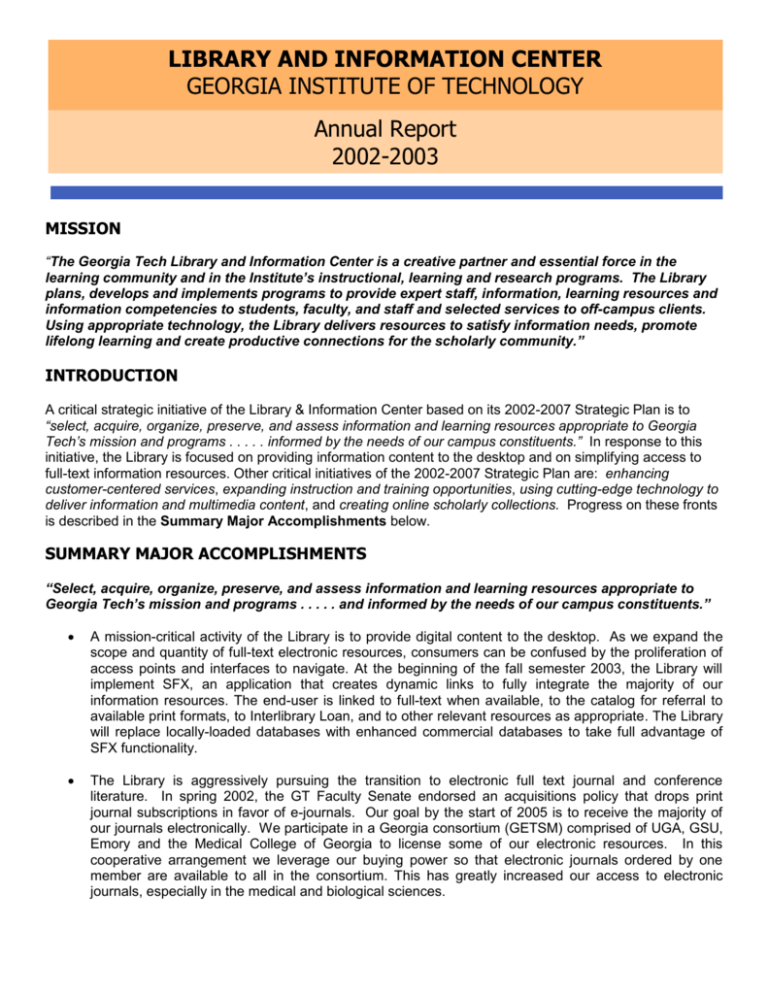
LIBRARY AND INFORMATION CENTER GEORGIA INSTITUTE OF TECHNOLOGY Annual Report 2002-2003 MISSION “The Georgia Tech Library and Information Center is a creative partner and essential force in the learning community and in the Institute’s instructional, learning and research programs. The Library plans, develops and implements programs to provide expert staff, information, learning resources and information competencies to students, faculty, and staff and selected services to off-campus clients. Using appropriate technology, the Library delivers resources to satisfy information needs, promote lifelong learning and create productive connections for the scholarly community.” INTRODUCTION A critical strategic initiative of the Library & Information Center based on its 2002-2007 Strategic Plan is to “select, acquire, organize, preserve, and assess information and learning resources appropriate to Georgia Tech’s mission and programs . . . . . informed by the needs of our campus constituents.” In response to this initiative, the Library is focused on providing information content to the desktop and on simplifying access to full-text information resources. Other critical initiatives of the 2002-2007 Strategic Plan are: enhancing customer-centered services, expanding instruction and training opportunities, using cutting-edge technology to deliver information and multimedia content, and creating online scholarly collections. Progress on these fronts is described in the Summary Major Accomplishments below. SUMMARY MAJOR ACCOMPLISHMENTS “Select, acquire, organize, preserve, and assess information and learning resources appropriate to Georgia Tech’s mission and programs . . . . . and informed by the needs of our campus constituents.” A mission-critical activity of the Library is to provide digital content to the desktop. As we expand the scope and quantity of full-text electronic resources, consumers can be confused by the proliferation of access points and interfaces to navigate. At the beginning of the fall semester 2003, the Library will implement SFX, an application that creates dynamic links to fully integrate the majority of our information resources. The end-user is linked to full-text when available, to the catalog for referral to available print formats, to Interlibrary Loan, and to other relevant resources as appropriate. The Library will replace locally-loaded databases with enhanced commercial databases to take full advantage of SFX functionality. The Library is aggressively pursuing the transition to electronic full text journal and conference literature. In spring 2002, the GT Faculty Senate endorsed an acquisitions policy that drops print journal subscriptions in favor of e-journals. Our goal by the start of 2005 is to receive the majority of our journals electronically. We participate in a Georgia consortium (GETSM) comprised of UGA, GSU, Emory and the Medical College of Georgia to license some of our electronic resources. In this cooperative arrangement we leverage our buying power so that electronic journals ordered by one member are available to all in the consortium. This has greatly increased our access to electronic journals, especially in the medical and biological sciences. The newly formed Collection Development and Management Department assumed responsibility for allocating and managing the Library’s $4.3 million materials budget for FY 2002-2003. It participated with Library Technical Services to assist in the migration to a digital environment supporting Open URL linking capabilities. This department coordinated a review of our locally loaded databases with the goal of migrating access to an interface that supports the Open URL Standard, enabling SFX linking technology. A Serial Review Project began in January, 2003, with the goal of canceling up to $500,000 in periodical titles. A database was created to both provide faculty with a list of our current periodical titles and to gather and organize data such as ISI Impact Factors, journal ranks within disciplines, LJUR (Local Journal Utilization Report) data and faculty input, which was a critical component of this project. Due to a $700,000 increase in the Library’s resources budget, the serials cuts are not expected to be as great as originally anticipated. Work began in late spring to integrate the IPST Haselton Library and Knowledge Center into the GT Library & Information Center. Comprehensive planning addressed personnel integration, assessment and integration of IPST collections and catalog records, acquisitions and subscriptions work, license agreement issues, digital initiatives, systems, space accommodations, and public services. Management of IPST’s proprietary research information remains a complex issue for further development. IPST integration is targeted for completion in June 2004, and presents a number of challenges in sustaining services to IPST clientele with no perceived erosion or inconvenience. The space vacated by the IPST Library in the IPST building is being considered for the Library’s Archives and Special Collections Department. “Enhance and expand customer-centered services at all levels to enrich research, teaching and learning.” The Library has captured the attention of the Institute’s students, faculty, staff and administration with its popular Library West Commons (LWC). The LWC provides students with basic productivity and multimedia workstations, enhanced with skilled information and technology assistance. The LWC has become an important destination for students who then remain in the Library to do research and study. Beginning fall semester 2003, both Library buildings (East and West) will remain open overnight to handle the steadily increasing numbers of students, and to provide access to all collections and circulation / reserve services. Library hours are noon Sundays through 6:00 pm on Fridays, in addition to Saturdays from 9:00am – 6:00pm. In 2002-03, the Library door count increased 56% over the previous year, from 530,000 entries to 830,000, the highest attendance in 15 years. Soon after the LWC opened, the Provost asked the Library Dean to develop plans for a 2 nd floor expansion of the facility. Initial discussions with GT students and faculty confirmed our thinking that the expansion would support group study accommodations. Along with OIT and CETL partners, we have developed a plan that provides 50 workstations for groups in a variety of settings, 10 of which are reserve-able rooms, with a total seating capacity for 240 students. We hope to test assumptions about the use of technology in these spaces as we await funding from the Provost for the Integrated Learning Resource Center (ILRC). The 2nd floor expansion will help us to explore concepts like how to effectively accommodate virtual tutoring between remote expert and assembled group (with support from ECE), the efficacy of a writing clinic (LCC-sponsored), and expanding opportunities for teaching assistants to set up office hours in the Library. In the meantime, a Library space near the LWC is being transformed into a presentation rehearsal studio for students, and will come on-line in fall 2003. The Library is in critical need of renovation. The West building opened in 1953 and the East building in 1968. In the intervening decades, study space was converted to book shelving, secondhand and inexpensive furniture was purchased to “make do”, and the original, clearly-defined arrangements of individual and group study spaces became muddled. Until 2002, modest funds were provided for improvements. Comprehensive remodeling, infrastructure modernization and furniture replacement is projected to cost $35 million. The GT Library, with the exception of the Library West Commons, is aesthetically unappealing, poorly furnished, inadequately cooled and heated, crowded . . . in short, in great need of a comprehensive renovation. We continue to petition the Institute for the needed upgrades and improvements to Library facilities. We have petitioned for an incremental renovation of the West and East Buildings as funds allow, beginning with the restrooms. The “Status of the Library Budget Basis for Five Years, FY 2003–2007” report (April 2003) recommends that the Library increase the size of its staff in order to better serve the needs of faculty and students and to raise Georgia Tech’s position in the Association of Research Libraries rankings particularly in relation to MIT (rank: 71) and other peer institutions. Georgia Tech is currently ranked 104. The 5-year plan recommends that 25 Library positions be added during FY2003–2007. The Provost supplemented the FY2003-2004 Library personnel budget by an additional $600,000 in pursuit of these goals for FY 2003-2004. The Library’s Information Delivery Department provides book loans, and this past year, the majority of photocopies free-of-charge. GT Library’s consortial agreements with ARCHE (Atlanta Regional Consortium for Higher Education), the University System of Georgia, and ASERL (Association of Southeastern Research Libraries, which includes Auburn, Clemson, Virginia Tech and 40 other institutions), supply materials from these libraries at no cost. Online interlibrary loan (ILL) request forms will debut in August 2003. The majority of the Library’s rare book collection will be moved into the Neely Gallery on 1st floor West Building following installation of new locked, glass-fronted bookcases in October 2003. The goal is to remove the rare books from the closed stacks in Archives and place them in a secure yet more visible location so that they will have a more immediate presence for library users. Space in the Neely area will be available by appointment for classes to view rare books and learn about them. The Neely Gallery anteroom (or Neely Lobby) will have a dual purpose as exhibit space and events space. Individual users will be able to request access to rare books in the Archives Department and the books will be used under supervision in the Archives reading room. “Use cutting-edge technology to store and deliver information and multimedia content to the computer desktop and create online collections for scholars.” In August 2003, the Library will introduce a comprehensive redesign of its website in accordance with Institute Communications and Public Affairs guidelines. In addition, a new Library Catalog interface will be introduced to provide improved navigability and functionality. The Library hopes to provide to GT information consumers a “federated search engine“ for simultaneously searching multiple databases, but there is not yet a good product in the marketplace. We are aware that many faculty and students prefer a more Google-like front-end so we continue to pursue opportunities in this arena. Electronic Reserves is a heavily used Library service, with 650,000 documents viewed in the past 12 months. At no cost to faculty, the Library provides access to a wide variety of scanned materials, including published articles, homework solutions, sample tests, PowerPoint presentations, images, etc., typically within 24 hours of submission. Students like the service because materials are always available at the desktop. In the months ahead we expect to facilitate access to streaming videos of digitally recorded classes. In fall 2002, the Library Copy Center moved to the 1st floor East and merged with Circulation Services, making copy machines more accessible to customers. Eight digital photocopiers were purchased, with two placed in the Architecture Library. A Minolta 6000 digital reader/printer was also purchased, allowing faculty and students to scan microformat materials and e-mail the resulting PDFs to their GT web mail account. In 2003, the Digital and Technical Services Division was charged by the Dean of Libraries to evaluate and improve the computing and networking environments in which the Library’s resources and services reside, and to accelerate the Library’s acquisition, management and creation of digital content. This Division will increasingly interact with campus customers to inform the Library’s “digital agenda”. The new Digital Initiatives Department will gather faculty research content, and, in partnership with these individuals and units, create workflows and establish technology standards to conserve this valuable knowledge store. The Information Control and Management Department will provide metadata services directly to campus units so that the organization and description of digital content is improved at points of campus origin. The Information Procurement Department (formerly Serials Control and Management) will participate with campus units to manage rights to Georgia Tech digital objects generated by the campus. The Archives and Records Management Department will interface with campus units to implement electronic records management. And the Systems Department will increasingly collaborate with OIT, GT portal designers, and instructional technologists on emerging, mutually beneficial opportunities. The Systems Department implemented a new design for the Library Intranet including new databasedriven components for Library policies and the staff directory. In addition, the Remedy help desk system was introduced to track hardware/software and electronic resources problems. A uniform GTID replaces the SSN number for user authentication purposes. The GT Portal Project, a campus-wide initiative to implement UPortal software, will be a priority for the GT Library Web Sites Team in order to integrate library services and resources into the “BuzzPort” portal. “Expand instruction and training programs for students, faculty, staff, and alumni to provide competencies for navigating the Internet and finding, filtering, evaluating and using information effectively.” The Library is identifying new ways to support learning communities. Examples are scheduling teaching assistants from schools of engineering in the consultation cubicles of the Information Services compound; working with CHALLENGE / OMED to incorporate an “information proficiencies” component into their summer curriculum; and engaging an increasing number of our librarians as faculty in “Psyc 1000” courses, who then are scheduled by fellow instructors to teach “information components” to their sections of freshman students. “Acquire, organize, preserve, and provide access to the official records of Georgia Tech and archival material related to the Institute, its history, faculty and alumni.” In January 2003, the Library’s Digital Initiatives Department was formally created and currently is staffed by 3 FTE. The major thrust of this department is to implement an institutional digital repository for the intellectual content of the campus. Digital repositories are important to scholarly communities in that they serve as tangible indicators of an institution’s quality, thus increasing its visibility, prestige, and public value. Library task forces, along with the Office of Sponsored Research and the Graduate Office are developing digital repositories: 1) The Electronic Theses and Dissertations (ETD) repository will provide electronic access to Georgia Tech dissertations and theses. The Graduate School and the Library funded a server for this application. Virginia Tech software was loaded and adjusted to meet GT Library needs. A test phase is proposed for the fall 2003 semester with electronic submission required for all graduates in the spring 2004 semester. Planning is underway to add IPST’s electronic dissertations to the Georgia Tech Library ETDs; 2) The Sponsored Research Digital Archives provides access to, and better control of, the final results of Georgia Tech sponsored research. The Office of Sponsored Programs (OSP) is in the process of acquiring new workflow management software for its internal use. Once this is complete, the Library will begin working with OSP to implement use of the database and web interface for electronic transmission of reports from that office. Additional digital projects and collaborations are being pursued by the Digital Initiatives Department. The Archives and Special Collections Department developed dynamic web pages for two Archives collections: the Georgia Tech Photograph Collection and the Griffin Collection. “Support professional development opportunities for staff to promote skills development in order to provide valued-added services and a dynamic staffing and management infrastructure.” The Digital and Technical Services Division’s staff skill sets are changing to an emphasis on management of e-resources, requiring higher-level skills and independent judgment. Changes in the economic and technological structure of scholarly communications, the rise of digital institutional repositories, new educational technologies, and wireless technologies are having a greater impact on the work of the Division. Training and development of new skills will inform the design of the Division’s work to best serve customer needs. SUMMARY OF PROGRESS IN ASSESSING INSTITUTIONAL EFFECTIVENESS Within the past 12 months, the GT community’s perception of the Library has taken a noticeable, positive turn. Whistle and Technique articles, opinion polls and editorial comments applaud the work that we and our OIT partners are doing to transform the Library into an essential presence. The Library is making unprecedented progress in measuring and assessing the services we offer. In this important cultural shift, we consider customer feedback and assessment as integral to understanding the relative merit of existing and emerging services. Insight is now continuously provided by quick surveys, comprehensive questionnaires, LibQUAL+, and unsolicited customer feedback. And we are more likely than in the past to attempt to understand the implications of it all. As we continue to assess and measure, we will apply critical thinking and exacting standards to our tools and techniques. The Library participated in the LibQUAL+ Survey (an international initiative of the Association of Research Libraries) in spring 2003. The survey results indicate that faculty, in particular, think that library resources are inadequate, that more information should be available electronically, and that new programs are not adequately funded. Although the Library’s materials budget has been flat for the last 5 years, in FY2003-2004, the Provost provided a budget increase for information resources of approximately $700,000. This increase will enable us to purchase faculty-requested resources and will facilitate the transition to e-journal content. In spring 2003, a Serials Review Project resulted in some journal cancellations to support needed acquisitions. Although the additional funds are of some help, inflation and increased demand for electronic and other resources continue to impact and deplete the budget. The Library West Commons (LWC) Customer Relations Team implemented fall 2002 and spring 2003 surveys to better understand how students and faculty use the LWC’s information services, technology support, productivity area, and multimedia assistance. “Tell Us Comments” is another way that the Library is able to assess LWC and other Library services and resources. An “Instant Poll” was also conducted for several months but was discontinued due to lack of reliable and usable data. Surveys and other assessment measures of LWC and the Library in general will continue on a regular basis.
